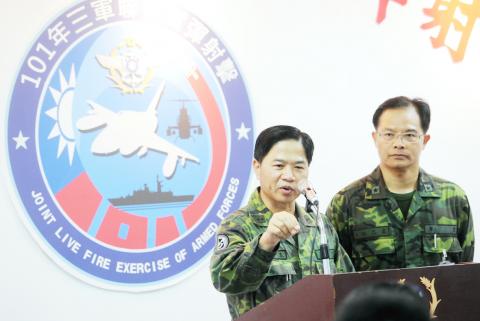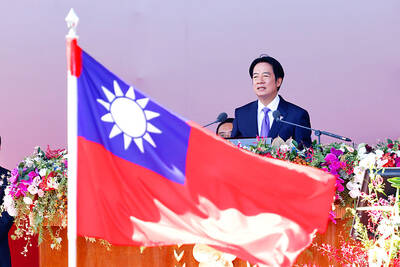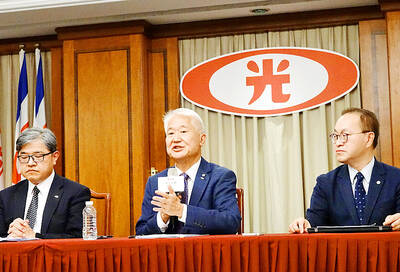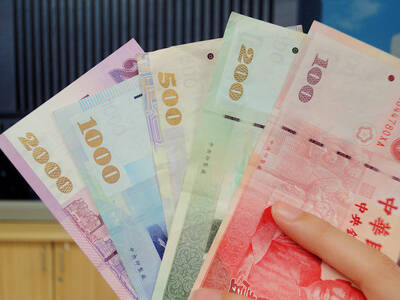The armed forces yesterday held a missile exercise in the south, substantially increasing the hit ratio from a similar drill in January last year with a 96 percent success rate.
In all, 26 missiles were fired from 12 platforms in the Joint Live Fire Exercise of the Armed Forces at the Chung-Shan Institute of Science and Technology (CSIST) missile test base in Jioupeng (九鵬), Pingtung County. Three services — the army, air force and navy — participated, with more than 2,300 soldiers mobilized for the exercise.
Things got off to a rather dispiriting start when the first two items on the agenda, the CSIST-developed Tien Kung II (TK-2) surface-to-air missile and a US-made ship-launched Standard Missile I (SM-1) surface-to-air missile, were canceled seconds before they were to be fired. Just over 15 minutes after successful intercepts by ground-launched Hawk and air-launched Tien Chien II (TC-2) and MICA missiles, a Hsiung Feng II (HF-2) anti-ship missile launch from a Lafayette-class frigate had to be canceled after a fishing vessel reportedly ventured into the naval exclusion zone.

Photo: Sam Yeh, AFP
Minutes later, a short-range HF-1, launched off a Jin Chiang-class missile corvette, hit its target, a decommissioned transport ship located 9 nautical miles (16.6km) into the Taiwan Strait.
From then on, the rest of the exercise went smoothly, with F-16-launched AGM-65 “Maverick” and AIM-9 “Sidewinder” missiles, and a “Ching Kuo” Indigenous Defense Force-launched TC-1, all hitting their targets in mid-flight. A ground-to-air version of the TC-1 also intercepted its target, while two AIM-9s launched by AH-1W Cobra attack helicopters hit their objectives.
Journalists cheered when the military announced that the HF-2 and SM-1 launches would now proceed, as the fishing vessel had cleared the area. While the SM-1, launched off a Perry-class vessel, intercepted its target, the HF-2 failed to hit home, missing another decommissioned transport ship 33 nautical miles at sea — the only miss that day.

Photo: Lo Pei-der, Taipei Times
During a press conference following the exercise, Ministry of National Defense officials said they were “quite satisfied” with the results, which enjoyed a 96 percent hit ratio.
A malfunction during the launch of two UK-made Banshee drones accounted for the aborted launch of the TK-2, officials said.
Turning to the presence of a fishing vessel, the military said 19 navy ships had been out at sea to secure the area, adding that one ship was sent out to force the intruders away from the area. The ministry confirmed the fishing vessel was foreign, but did not give their country of origin.
However, an official said that if Chinese ships had been present — during exercises in the past, China sometimes relied on fishing vessels to gather intelligence — some types of missiles would not have been launched.
The US-made AIM-7 “Sparrow,” which malfunctioned and dropped into the sea immediately after being launched during last year’s exercise, was excluded this year. The ministry said the US was still investigating the cause of last year’s failure and added that the decision not to include it had also been made for safety considerations, given the advanced age of the missile.
A ship-launched CK-3 Banshee drone also experienced technical failure and fell in Pingtung City, blowing a small crater in a road, officials said.
President Ma Ying-jeou (馬英九), who had expressed dissatisfaction after attending last year’s exercise, which scored a 68.4 percent hit rate with six misses from 19 missiles launched, was not present yesterday.

People can preregister to receive their NT$10,000 (US$325) cash distributed from the central government on Nov. 5 after President William Lai (賴清德) yesterday signed the Special Budget for Strengthening Economic, Social and National Security Resilience, the Executive Yuan told a news conference last night. The special budget, passed by the Legislative Yuan on Friday last week with a cash handout budget of NT$236 billion, was officially submitted to the Executive Yuan and the Presidential Office yesterday afternoon. People can register through the official Web site at https://10000.gov.tw to have the funds deposited into their bank accounts, withdraw the funds at automated teller

PEACE AND STABILITY: Maintaining the cross-strait ‘status quo’ has long been the government’s position, the Ministry of Foreign Affairs said Taiwan is committed to maintaining the cross-strait “status quo” and seeks no escalation of tensions, the Ministry of Foreign Affairs (MOFA) said yesterday, rebutting a Time magazine opinion piece that described President William Lai (賴清德) as a “reckless leader.” The article, titled “The US Must Beware of Taiwan’s Reckless Leader,” was written by Lyle Goldstein, director of the Asia Program at the Washington-based Defense Priorities think tank. Goldstein wrote that Taiwan is “the world’s most dangerous flashpoint” amid ongoing conflicts in the Middle East and Russia’s invasion of Ukraine. He said that the situation in the Taiwan Strait has become less stable

CONCESSION: A Shin Kong official said that the firm was ‘willing to contribute’ to the nation, as the move would enable Nvidia Crop to build its headquarters in Taiwan Shin Kong Life Insurance Co (新光人壽) yesterday said it would relinquish land-use rights, or known as surface rights, for two plots in Taipei’s Beitou District (北投), paving the way for Nvidia Corp to expand its office footprint in Taiwan. The insurer said it made the decision “in the interest of the nation’s greater good” and would not seek compensation from taxpayers for potential future losses, calling the move a gesture to resolve a months-long impasse among the insurer, the Taipei City Government and the US chip giant. “The decision was made on the condition that the Taipei City Government reimburses the related

FRESH LOOK: A committee would gather expert and public input on the themes and visual motifs that would appear on the notes, the central bank governor said The central bank has launched a comprehensive redesign of New Taiwan dollar banknotes to enhance anti-counterfeiting measures, improve accessibility and align the bills with global sustainability standards, Governor Yang Chin-long (楊金龍) told a meeting of the legislature’s Finance Committee yesterday. The overhaul would affect all five denominations — NT$100, NT$200, NT$500, NT$1,000 and NT$2,000 notes — but not coins, Yang said. It would be the first major update to the banknotes in 24 years, as the current series, introduced in 2001, has remained in circulation amid rapid advances in printing technology and security standards. “Updating the notes is essential to safeguard the integrity